Det ska väl gå att ordna.
Fond för bevarandet av malawiciklider
Kollaps
X
-
Igen dags för lite nyheter från Ad Konings om SMG-fondens verksamhet:
Dear Friends,
You may have heard through the grapevine that the so-called
Tanzania Murago is still around in the lake. A few friends and I visited the
site last July and although the population has suffered visibly, the species is
still there. I estimate that about 50% of the population has been removed and,
interestingly, the fish from adjoining areas did not (yet?) occupy the empty
space from where the Tropheus was caught. So snorkelers swimming in one
direction didn’t see a single individual while those in the opposite direction
started to find them in seemingly normal numbers. We were all relieved. Let’s
hope that those aquarists keeping this form breed them in sufficient quantities
so that we don’t need to rely on the natural population.
The breeding station setup at the Lakeshore Lodge in Kipili
is progressing. Chris had been waiting for a compound to put on the inside of
the vats to seal them, which he has applied in the meantime. Last week he and
his staff dug a 500-foot-long trench from the lake to near the vats to hold the
water intake line from the solar pump at one end, to a 5000-liter container on
the other.
Omega One has already contributed to the Fund through the
sale of their Frozen Cichlid Formula—Thank you!—and Kelly Randall, the marketing
director of Omega Sea, has also sent a box with Super Kelp Flakes to Kipili as
food for the breeders. Great!
Lake Malawi
We have also news from Matt, manager of the Blue Zebra
Lodge on the Maleri Islands in Malawi. He anticipates more pressure on the
fishing around the islands because of the poor rainy season leaving the lake
almost two feet lower compared to last year and thus affecting crop yields. Matt
also supplied a list of illegal activities recorded on and around the Maleri
Islands and found that they are in better control of the illegal fishing.
He credits the improving numbers to three factors: 1.January to March
2014January to March
2015Illegal
fishing3 1 Arrests 17 3 Fire places 6 2 Tree cutting 1 0
Change in the routine patrol, 2. increased availability of resources, and 3.
higher penalties charged to offenders. Matt thinks that the recorded
improvements are due to better prevention (several patrols per month) and also
to better dialog with the communities. As an example of the latter he mentions
that the local (Maganga Village) soccer team, which is sponsored by the lodge,
changed their name from “Fisherman Club” to “Blue Zebra Club”.
Nevertheless, Matt remarks, their efforts are not totally
persuasive. Every week, he still removes long fishing lines from the no-fishing
zone at Nakantenga Island, and six of the ten demarcation floaters he installed
last year have gone missing.... Thank you very much for your report, Matt!
There is some progress on the guard’s boat that is being
fitted in South Africa. The hull has now been prepared to receive the customized
diesel engine and Dimitri hopes the boat will be operational before the end of
the year.
Thank you
The Fund recently received a big infusion from the Babes In
The Cichlid Hobby; a whopping $4,500!! With the help of many donors who supplied
them with numerous cichlids and fish-related goods, they auctioned and auctioned
during the Springfield ACA convention this summer. Thank you so much, ladies! A
good chunk of the donation went straight to Tanzania to assist Chris and Louise
in completing the breeding station.
I would also like to thank Mikael and Magnus Karlsson, the
discoverers of the Tanzania Murago (among many other fish), who donated the
stipend for their article in Cichlid News to the Fund.
Thank you ALL for securing the cichlids’ future and for keeping extinction out off our tanks!
AdSenast redigerad av Mikael W; 06 september 2015, 07:28.mvh
Mikael W
(NCS-medlem sedan 1981)Kommentar
-
En kort uppdatering från Ad:
Dear Friends,
Larry Johnson just returned from Malawi where he and his group again released about 60 P. saulosi at Taiwanee Reef.Thank you David and your team at Stuart Grant Ltd. for breeding these!! As usual they did a short swim around and count all the P. saulosi they saw before the new fish were released. In 2013 we counted on average about 40 individuals during a 15 minute survey, and in 2014 Larry counted about 55. This year Larry and Pete Barnes counted about 175 in a 10 minute survey!!! The other divers soon lost count as there were several groups of 15-30 individuals! Even though this is fantastic news, P. saulosi is far from being recovered completely. One of the safari participants, Chris D’Amour, sent me some footage of Taiwanee Reef videoed while he swam around. On it there are still very few P. saulosi and the huge schools that used to cover the upper rocks 25 years ago appear to not have recovered as of yet. But everything looks like that they will as long as we abandon collecting the population. I want to thank Larry and his friends for releasing the P. saulosi for the third time, and also everyone who refrained from buying wildcaughts or asked wholesalers to import some. The video shows the release of the P. saulosi and was again shot by Peter Barnes. Thank you again, Pete!
David at Kambiri managed to breed Melanochromis chipokae in good numbers and we need to focus on releasing that species back to the lake. More on that next time, I hope.
Melanochromis chipokae in good numbers and we need to focus on releasing that species back to the lake. More on that next time, I hope.
Two weeks ago I received some photos of the guard’s boat in which they managed to install the diesel engine. Everything had to be customized for a proper fit and that took a long time to figure out, but soon it will be shipped to Malawi.
About a month ago I received the following letter from Estelle (manager of the Blue Zebra Lodge on Nankoma Island):
There has been a lot going on since Matt sent you the update.
At the end of June the fines for poaching in the park disappeared because the trustee members were no longer willing to collect them. As a result, Lake Malawi National Park decided that it was time to apply in LMNP the same rules as are in effect in any other Malawi park. This meant that poachers caught in the act would be taken directly to the police and sentenced by the court.
Following this new procedure, three fishermen were caught while fishing within park boundaries and brought to the police. This caused a provocation and a harsh reaction from the local community who demonstrated on the 27th of July, first blocking access to our staff and then marching towards Salima boma to the district house. The fishermen demanded immediate release of the three fishermen and the right to fish at the Maleri Islands. The fishermen were released the same day and a committee meeting was held on August 28th discussing the issue of fishing in Lake Malawi National Park. Present at this meeting were the Lake Malawi National Park manager, the District Commissioner, the Police District, the TA, and representatives of the fishermen.
It was agreed that the fishermen would have the right to stop and rest in one of the bays around the islands in case of harsh weather only, but it was underlined by Park authorities that the law cannot be changed and that the 100m no-fishing zone is not negotiable and that any fisherman fishing within this area would be persecuted for poaching.
This event had reached very high up in the government sphere and they have been very supportive and protective of the park laws. For now, the fishermen are still trying to break the law but we can see their attempts are getting fewer. All in all I think that now that the fishermen have been officially warned by the highest authorities it will make the job of LMNP patrols easier and we can already see good results coming out of the event.
Thank you, Estelle, for keeping us informed about the struggle of keeping fishermen out of Park waters.
Thank you ALL for securing the cichlids’ future and for keeping extinction out off our tanks!
Ad
You can see the video/photos at:
mvh
Mikael W
(NCS-medlem sedan 1981)Kommentar
-
En färsk rapport från Ad Konings finns på: http://cichlidpress.com/smgfund/smgfund30.html
Ad nämner också oss på slutet av rapporten:
"I’m also indebted to the Nordiska Ciklidsällskapet (Scandinavian cichlid society) for fundraising among their membership which resulted in $1021 for the Fund! Tack så mycket! Ad"
Ad
mvh
Mikael W
(NCS-medlem sedan 1981)Kommentar
-
Här kommer en kort färsk uppdatering från Ad Konings
Dear Friends,
A very short update on the progress we have made protecting cichlids in lakes Malawi and Tanganyika. The recent release of the second species at risk in Lake Malawi is the highlight of this update.
Melanochromis chipokae
Within one year after we had met Pierre le Roux at his fish farm in Chipoka he managed to catch the breeders for M. chipokae, breed them, grow the offspring in record time, and last month, on May 26th, Pierre and his son Jean released the first 68 offspring back at Chidunga Rocks! Watch the video, shot by Jean, in which Pierre releases the fish near the bottom of the shallow reef:
First release of Melanochromis chipokae at Chidunga Rocks
Pierre has another 90 juveniles to be released and also has had success in breeding Aulonocara baenschi of which he has about 150 juveniles that are about ready to be reintroduced at Nkhomo Reef. Later this year, Mattia Matarrese and colleagues from Perth, Australia, will assist Pierre in releasing both species while Larry Johnson with his group will again visit Taiwanee Reef to maybe release more Chindongo saulosi, but more importantly take a survey of the current population.
Lake Tanganyika
Chris and Louise Horsfall are successful in breeding Oreochromis tanganicae, the tilapia found throughout the lake. They found that the fingerlings won’t grow as fast as those of O. niloticus or O. mossambicus, but fast enough to make farming them a viable business, also for Tanzania. For years the Mpende Fisheries farm near Ndole in Zambia has been successful in raising O. tanganicae in large quantities in cages in the lake. The four countries surrounding Lake Tanganyika have all committed to prohibit the introduction of exotic species in fish farms situated around the lake and banned the farming of O. niloticus and other staple species grown throughout the world.
Later this year, in September, we will collect the breeders for the program aimed at reintroducing some of the species at risk of extinction. We will try to catch some Tropheus duboisi “Maswa”, some Tropheus moorii “Tanzania Murago”, and some breeders of Ophthalmotilapia boops “Blue Neon”. At the same time we will setup the cichlid census program to give us baseline densities of certain species. We will find out what is all involved, how much the program would cost if we hire a Tanzanian student to do it, and what species and localities are feasible. We have acquired five cameras which we will field test in September for this purpose.
Remember that a portion of each package of Frozen Cichlid Formula of Omega One supports the Fund!
Thank you all for your support and concern for our cichlids in the wild.
Ad
Den ovannämnda filmen på när de släpper ut odlade Melanochromis chipokae finns på SMG-fondens hemsida: http://cichlidpress.com/smgfund/smgfund31.html
Senast redigerad av Mikael W; 18 juli 2017, 15:36.mvh
Mikael W
(NCS-medlem sedan 1981)Kommentar
-
Ave
Ad Konings har skrivit en uppdatering från SMG-fonden (jag lyckades inte få in videon, se den på http://cichlidpress.com/smgfund/smgfund32.html):Dear Friends,
After a hiatus of more than one year I want to update you on the developments regarding the protection of cichlids in lakes Malawi and Tanganyika. There have been some developments at both lakes and those in Lake Malawi have not been very favorable for the wellbeing of fish populations.
A little over a year ago Larry Johnson and seven other participants of his safari on Lake Malawi set out to Taiwanee Reef to release a whopping 700 C. saulosi that David Nkwhazi of Stuart Grant Ltd had bred for reintroduction. Unfortunately the visibility at the reef was very poor and no count of C. saulosi was made prior to the release. However, the video of the release (thank you Pete Barnes) shows that there were no resident C. saulosi visible in the area of release. There have also been reports that wild C. saulosi were offered for sale in Germany and China. Whether these were collected at the reef or captivity raised could not be determined, but I’m afraid that publicizing our reintroduction efforts also informs individuals with no scruples about extracting the last few specimens to make a buck.
2017 Release of Chindongo saulosi at Taiwanee Reef. Video by Pete Barnes.A similar scenario was met by Mattia Matarrese and his team who, together with Pierre le Roux, visited Chidunga Rocks to prepare for the release of a second batch of Melanochromis chipokae. They couldn’t find a single individual of M. chipokaeeven though Pierre had released 68 fish in May. Also here I fear that most of these were extracted by collectors. It was decided to not release any more chipokae at Chidunga Rocks till a time when the ornamental fish collectors stop targeting these rare species. We are still breeding these and other species in Malawi and Pierre has been gracious enough to hold stocks of them at his facility. I have spent the better part of seven months updating the status of all Malawi cichlids for the recently released red list update by the IUCN and at a workshop in Malawi in May this year it became clear that a huge number of species have disappeared. Most significantly for Malawi, the principal food fishes Chambo (Oreochromis species) and Kampango (Bagrus meridionalis) have decreased more than 99% in population density compared with data of 20 years earlier. Still there is no regular collection of data about what fish and in what quantities are being caught around the lake. The Utaka have been heavily overfished and now the lake water is slowly getting turbid as the fish that used to eat the plankton has been all but eliminated. The sole species which showed an increase in population density was the Usipa, the lake sardine, as it now has more food available. However, the commercial trawlers are now targeting this species and it is expected to have declined at the next census. There is fortunately some good news from Malawi. Ripple Africa, a non-profit organization based in the UK and led by Geoff Furber, managed to convince the government that it would be better for the fish and fishermen to empower the local communities and allow them jurisdiction of the lake’s shoreline. They have established about 200 fish conservation committees and have setup bylaws in Nkhata Bay and Nkhotakota. Now that each village along the lake shore owns the right to fish and is able to arrest and fine fishers from other villages who intrude on their portion of the lake, the fish now appears to slowly return to normal densities. Also illegal nets, such as mosquito nets which were used to catch the tiniest of fish in the very shallow water, have largely been abandoned in the areas which were converted by Ripple Africa. Check out their website and find out the staggering number of confiscated mosquito nets. Lake Tanganyika
While the authorities in Malawi do little to nothing about the rampant overfishing going on in the lake the situation in Tanzania on Lake Tanganyika is much better. The authorities try hard battling illegal fishing, partly supported by visitors who want to see the cichlids in the lake. The have imposed fees—$50/week/visitor—which are used for a special police force patrolling the entire shoreline of Tanzania and arresting any fisherman with illegal nets or while fishing in forbidden areas. I have just returned from a trip in Tanzania and Zambia and have noticed the difference in fish densities in Tanzania compared to those in Zambia where there is very little oversight, similar to Malawi.Zambia used to have more than 20 commercial trawlers that targeted the open water fish, Kapenta (Limnothrissa and Stolothrissa), and in the 1990s fisheries was sure that there would be no end to the Kapenta fishing. Huge quantities of Kapenta were caught at night, attracted by lights, frozen in large warehouses, and then shipped to Lusaka or even exported to other countries. More than 10 years ago it became clear that Kapenta was limited and every commercial company has abandoned its collection. Still, Kapenta has not yet returned and the local fishermen are actually poaching in Tanzanian waters to catch some. With the cichlid stocks it is not much different: shallow water sand-dwelling cichlids have basically disappeared in Zambia while any fish that dared to swim out into the open water has been captured. Nowadays fishermen use small-meshed gill nets that are draped near shore and by throwing rocks and by loud splashing on the surface they hope to scare a few fish into the net. Not only are the food fishes threatened with extinction in Zambia also the ornamental fish collectors have wreaked havoc on the more popular species such as the all-orange Neolamprologus mustax, the yellow and the white Altolamprologus calvus, the so-called Transcriptus Gombe, and various others that are also targeted by the food fishermen. We also visited Toby Veall’s compound and were happy to see that many vats were dedicated to breeding the Maswa Duboisi and all appeared in good health. 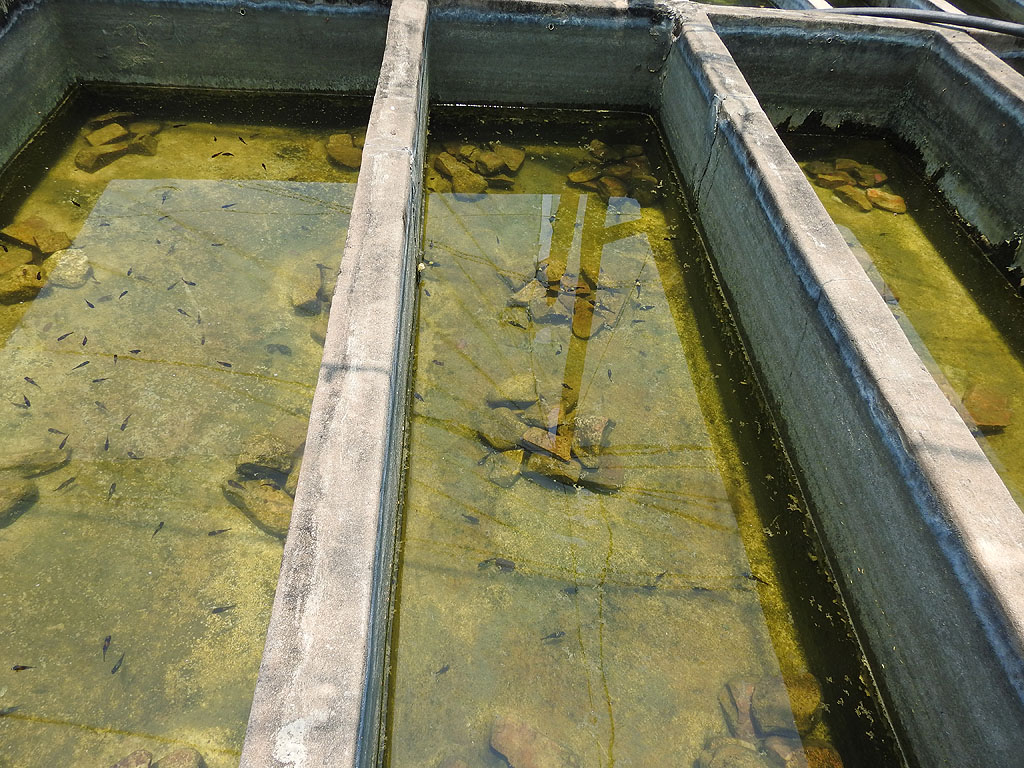 Some of the vats with breeding groups of Tropheus duboisi "Maswa" at Toby Veall's Kalambo Lodge.
Some of the vats with breeding groups of Tropheus duboisi "Maswa" at Toby Veall's Kalambo Lodge.Chris and Louise Horsfall of the Lakeshore Lodge in Kipili are successfully breeding several threatened species which they will hold till such time they are no longer targeted in the wild. At present more than 80% of the fish collected by the ornamental fish trade is exported to Asia with more than 11 exporters operating in Tanzania alone! We are in this for the long haul. This year was a great year for our fundraising as we received a little over $12,000! Our total from 2007 till now stands at $98,205! I would like to thank Mattia Matarrese and the Perth Cichlid Society, Steve Edie and the Missouri Aquarium Society, Dick Au, the Nordiska Ciklidsellskapet, Patrick Tawil, Associazione Italiana Ciclidofili, and the Babes in the Cichlid Hobby for their large donations to the Fund. Thank you ALL for your support and concern for our cichlids in the wild. Remember that a portion of each package of Frozen Cichlid Formula of Omega One supports the Fund!
Ad
Det finns också en kort hälsning från Ad Konings till NCS här: https://www.ciklid.org/forum/forum/%...om-ncs-och-smg.
Admvh
Mikael W
(NCS-medlem sedan 1981)👍 1Kommentar
-
Hej
Fick nyss ett mail från Ad Konings, han har skrivit en rapport om SMG-fondens verksamhet i år. Klipper in den här:
Dear Friends,
A year has gone by and many cichlids in lakes Malawi and Tanganyika are still threatened with extinction due to overfishing by local fishermen and extraction of the rarer forms by the ornamental fish trade. I will summarize the highs and lows of our conservation efforts in 2019 below.Lake Tanganyika
Chris and Louise Horsfall are successfully breeding three species of cichlids threatened with extinction through over-collecting by the ornamental fish trade. In fall 2020 we maybe ready for reintroduction of at least two of them. Their breeding setup is working as it should with lots of lake water flowing through the system pumped by a solar pump.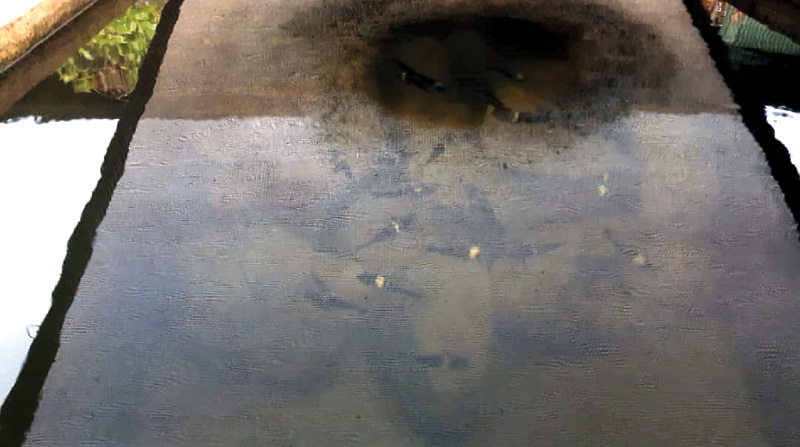 The breeding group of Maswa Duboisi at Lakeshore Lodge in Kipili, Tanzania. Photo by Chris Horsfall.
The breeding group of Maswa Duboisi at Lakeshore Lodge in Kipili, Tanzania. Photo by Chris Horsfall.On July 16th of this year Chris and Louise received, “…an as promised visit from the Permanent Secretary of Fisheries, Dr. Rashid Tamatamah. He arrived with an entourage of about 40 people. He is a super guy who has passion in his veins. I showed him what we have managed to do with your input and the Stuart Grant Fund and he was very impressed and concerned. I mentioned all our concerns about the future projections of the lake and her fish and he shared his concerns and thanked us for making him aware. He has committed his ministry to helping, listening to, and working together to secure the lake’s future for us all.” Earlier in the year the Horsfalls had a visit from Dr. Tim Davenport, director of the Wildlife Conservation Society in Tanzania, species director of Africa, and discoverer of a scientifically completely unknown monkey in Tanzania in 2003 (see www.tanzania.wcs.org/Staff.aspx). He pointed out to us that Tanganyika cichlids, or any cichlid for that matter, are not on any CITES list, which he mentioned is a crucial first step in protecting any cichlid in the long run. He explained to me that “…CITES is a trade organisation primarily and not as many believe a conservation one; but it is the only such international institution and one with global significance and to which all states are signed up. What I am advocating therefore is not specific management per se, but strengthening the political process. It is not the answer to the problems. However, I believe it is a vital first step in the political process in order to tackle the issue. There is currently no incentive for any nation to control this trade [in cichlids]. Getting cichlids (or a subset thereof) finally listed not only begins that process, but I would argue is essential if any genuine progress is to be made. Currently cichlids are off the international wildlife trade radar, which in itself is staggering. In order to get them there, they need to be CITES listed. If they are not listed, then the default official assumption is that they are fine.”
Dr. Davenport offered to initiate the process which will take more than a year to accomplish as it “…requires both technical and political and communication elements but I believe it is not only doable but we can demonstrate why a proposal coming from Tanzania is ideal.”
We are all looking forward to the day when cichlids are no longer lawlessly traded. I will keep you updated on the progress placing cichlids on a CITES II list.Lake Malawi
Since Larry Johnson or anyone else didn’t organize a safari to Lake Malawi this year there is no news on the wellbeing of Chindongo saulosi at Taiwanee Reef. During his 2018 trip Larry found low visibility at most places he dived at, possibly caused by the large-scale overfishing of utaka with a subsequent bloom of the algae. Murky water is good for the lake sardine, the Usipa, and most fisheries are now concentrating on collecting that species instead.
Pierre le Roux is still breeding and holding Melanochromis chipokae and Aulonocara baenschi and we are planning for a release of these species in 2020. Pierre le Roux is breeding and growing Aulonocara baenschi in these huge tanks at Chipoka, Malawi.
Pierre le Roux is breeding and growing Aulonocara baenschi in these huge tanks at Chipoka, Malawi.In the meantime Geoffrey Furber and his team of Ripple Africa are getting more results from their conservation activities in northern Malawi. Now that they have empowered many fishing villages in the northern sector of Lake Malawi to take control of “their” part of the lake, these villages are now examples of how fishing should be done throughout Malawi. Ripple Africa is now trying to implement the empowering protocol in the central part of the country. This is a long process where village authorities and select fishermen pay a visit to some of the northern villages to see first-hand what can be achieved. Such visits are organized and paid for by Ripple Africa as well, because the overall effect is that fishermen, after having seen how it can be done, want to implement the method in their own village as soon as possible but are faced with authorities who prefer the “old method” often involving illegal nets, poaching, and bribing.  After decades without seeing the lake trout, Mpasa, a fisherman caught one at Kaweta Beach in the Nkhata Bay District in June 2019. Photo by Ripple Africa.
After decades without seeing the lake trout, Mpasa, a fisherman caught one at Kaweta Beach in the Nkhata Bay District in June 2019. Photo by Ripple Africa.
End July this year I received the first message from Reza Sacranie, a conservationist and resident of Malawi who lives at Namaso Bay right on the border with Lake Malawi National Park at Nkhudzi Hill. He wrote, among many other wrongs that are deteriorating life for Malawians: “…the pair trawlers, almost all owned by members of parliament, are everywhere, using illegal size nets; the subsistence fishermen no longer have a chance in the open water so they now are forced to fish in rocky and reedy areas which are mostly in the protected areas or chase the trawlers for crumbs.” He is very worried about the poaching in the National Park by fishermen and has installed ANDs (anti-netting device) near his property and National Park which seem to work well. It appears that Fisheries or any other authority has no plan to prevent these trawlers from using illegal nets or prevent them from fishing in restricted areas in the southeastern arm of the lake, which are off limits to the local fishermen.
After having brought Reza in contact with Geoff from Ripple Africa, a plan was made to already start the conversion of the fishing villages and empower them to take matters in their own hands. This will be a long process as many village authorities have been corrupted by the owners of the trawlers and reliable leaders have to be selected to start the process with. Our Fund has donated $3000 to Ripple Africa aimed at the first selection of representatives of the various fishing villages along the SE arm of the lake and to educate them about the new approach. It will also cover in a large part an organized trip to the Nkhata Bay area where selected delegates can learn how village empowerment and nursery ground protection helps the fishes to reestablish themselves and provide greater catches of larger fish. These are the mosquito nets that were used for fishing, confiscated early October 2019 in the Salima District
These are the mosquito nets that were used for fishing, confiscated early October 2019 in the Salima District
(central Lake Malawi). Photo by Ripple Africa.
The first of those meetings took place September 13-14 in Mangochi. Here some excerpts from the report:
“Mr Force Ngwira, Country Director for Ripple Africa, and Mr Dellings Kamenya, District Fisheries officer (DFO) for Nkhata Bay district, were invited to Mangochi District to meet with Mangochi DFO, Lake Malawi National Park officials, TA (Traditional Authority) Nankumba, Councilors and some community members from Lake Malawi National Park surrounding area. Ripple Africa were asked to share their experiences of what is happening in Nkhata Bay District under the Fish For Tomorrow fish conservation project, and given the opportunity to learn about fisheries related interventions being implemented in Mangochi District. The main objective was for the two sides to discuss success stories and challenges faced and plan an educational visit for Mangochi stakeholders to see what is happening in Nkhata Bay.
After the meeting, the Mangochi DFO took us to Makawa Beach where we saw with our eyes a lot of illegal fishing gears. There were more than 150 Chirimila fishing nets with large mosquito nets in the middle of each of these nets.
Early in the morning of the following day, we drove to the opposite side of the lake and visited some beaches at Malindi Mission Hospital area. We were all saddened and felt very sorry to see baby Usipa, locally known as Bonya, spread on drying racks which were caught the previous night by local fishermen who seem not to care about the future of the lake and their own children.
As if this was not enough, a lot of illegal fishing gears—mainly huge drag nets made by joining approximately 100 to 200 mosquito nets together—were drying on the beach in preparation for another day’s fishing. There were probably over 150 very large nets all made out of mosquito nets. We never saw a single legal fishing gear.”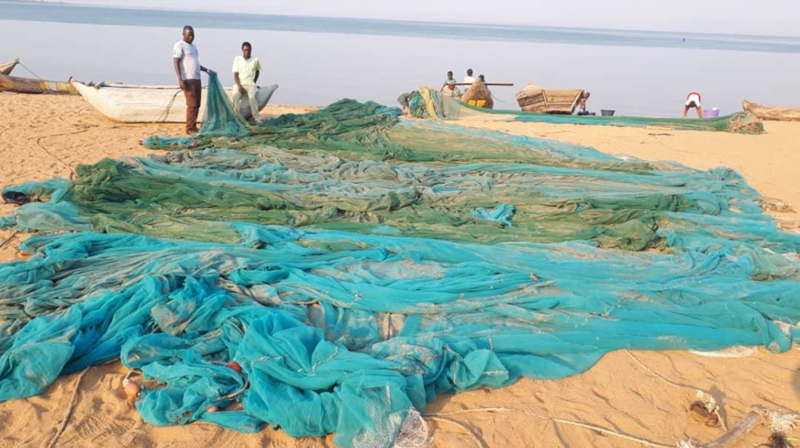 Illegal fishing gears—mainly huge drag nets made by joining approximately 100 to 200 mosquito nets together—drying on the beach in preparation for another day’s fishing. Photo by Ripple Africa.
Illegal fishing gears—mainly huge drag nets made by joining approximately 100 to 200 mosquito nets together—drying on the beach in preparation for another day’s fishing. Photo by Ripple Africa.As you can see the biggest concern is the illegal use of mosquito nets for fishing and a great deal of activity performed by the village authorities in northern Malawi is confiscating such nets. Some of the raids resulted in literally thousands of seized mosquito nets which are then burned preventing further deployment.
In addition to us assisting Ripple Africa in a small way also the ACA appears to be interested in helping the non-profit. It is a long and difficult way but I believe that the method of fish conservation that Ripple Africa has introduced is the only way to ensure a future for Malawi cichlids and for the local fisherman.I want to end this message to thank all of you who have contributed in 2019 to the Fund to conserve the cichlids in lakes Tanganyika and Malawi. Thank you! $1 to $99:
Patrik Hultqvist
Kaikoa Anderson
Genki Furumura
Kasuaki Kasai
$100 to $999:
Findurnemo
Jimmy Bjerenius
$1000+:
Nordiska Ciklidsällskapet (Sweden)
Perth Cichlid Society (Australia)
Dick Au (USA)
Patrick Tawil (France)
Babes in the Cichlid Hobby (USA)
Ad


 mvh
mvh
Mikael W
(NCS-medlem sedan 1981)Kommentar
-
Hej
Det kom en kort uppdatering från Ad. Pga covid-pandemin har han inte kunnat besöka sjöarna på ett och ett halvt år för att kolla själv. Så här skriver han:
Dear Friends,
It has been almost two years since I have reported on our conservation work on lakes Malawi and Tanganyika. We all know why there was such a hiatus and I hope dearly that every one of you came through this (ongoing) pandemic unscathed or fully recovered. With travel to Africa greatly restricted for about 16 months there have been no “eyes” underwater to observe the situation regarding our threatened cichlids, but action is picking up in Malawi by local conservationists and sympathizers. Even though I have little to report from projects sponsored by our Fund, I recently received several important news items from Lake Malawi's defender, Reza Sacranie, that I like to share with you.
Illegal Fishing
First off, an undercover Malawian journalist found out how easy it was to fish with a non-licensed trawler using illegal nets at an illegal time in the southeastern arm of the lake. The whole procedure was explained as front-page news in Malawi’s number one newspaper, The Nation. The link to the newspaper’s website with the story is here but I also have it as a pdf file as I fear it will be removed soon under political pressure. When you read the story you should remember that one US dollar is about 800 Malawi Kwacha (MK). You’ll read that the Village Chief, head of the so-called Beach Village Committee, and the local fisheries boss are all three in on the deal allowing illegal (non-licensed) trawlers using illegal (small-meshed) nets to deplete the fish stocks in that part of the lake. Just for that particular village they allowed, besides the 11 licensed trawlers, about 40 extra illegal trawlers who each pay a daily bribe of $25 to the fisheries boss to sometimes make tens of thousands of dollars per trawler selling poached fish. The few men in power receive a daily $1000 and are selling out the fish of Lake Malawi and the livelihoods of the local fishermen. And that is just a single village. Read the article and you’ll be outraged.
Water for sale
Another point of contention is the construction of a water intake site right in the National Park at Nkhudzi Hill. You can read about it here. And a video produced by a local agency can be viewed here.
I’m afraid that the water pumped out of the lake is going to be used for other purposes than to supply “safe” drinking water for the local population. The authorities sounded concerned about the 92,000 locals who initially thought they would get the water for free (!), but the way this project was pushed through all kinds of regulations and restrictions—most of all building it inside the World Heritage Site!—suggests that buyers with deep pockets are waiting for the pumped water to use for other purposes than safe drinking water. Not only the fish but now also the lake’s water is up for grabs by some people in power.
Reza, who has started the organization Lake Shepherd, is under continuous threats from the authorities embroiled in this water pumping scheme but now that Lake Shepherd’s views and comments have been publicized in the media he feels a bit safer for his family and employees.
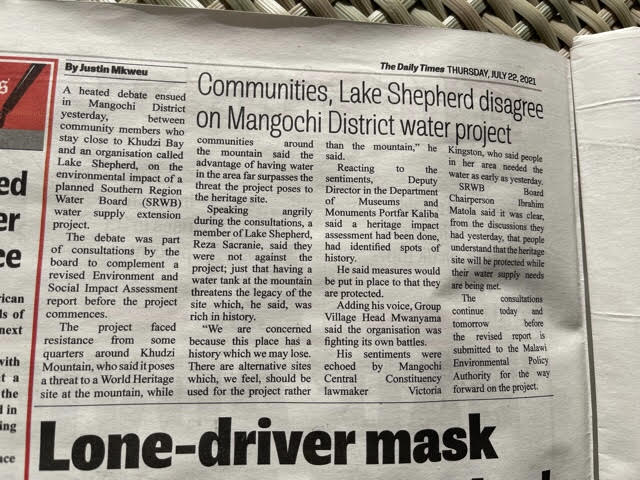
The article in the Daily Times describing Reza being "angrily speaking" at the hearing for building a water pump site in Lake Malawi National Park
Ripple Africa
On a more positive note it appears that Ripple Africa, led by Geoff Furber, has received funding from UNESCO to start working with the fishing communities along the southeastern arm of the lake on decentralized management. Their projects show to be very successful in the northern part of the lake (see previous reports) and now that they have received the funds are able to gradually implement their methods also in the southern part.
I have no news to share from Lake Tanganyika but I will be at the lake in October and hope to report on developments from there later this year. I want to end this message to thank all of you who have contributed to the Fund, even through the pandemic, to conserve the cichlids in lakes Malawi and Tanganyika. Thank you!
Ad
mvh
Mikael W
(NCS-medlem sedan 1981)Kommentar
-
Hej
Här kommer en uppdatering från Ad Konings om SM>G-fondens verksamheter vid Tanganyikasjön och Malawisjön:
Dear Friends,
It has been a year that I have reported on our conservation work on lakes Malawi and Tanganyika. I was at Lake Tanganyika last October and there are some developments in the southern part of Lake Malawi to report on.Lake Tanganyika
Chris and Louise Horsfall are still actively breeding Tropheus duboisi “Maswa” and Tropheus moorii “Tanzania Murago”. For the second time in the last three years the adults of the Maswa breeding group suddenly died while the juveniles in the same vat with them survived. We now think that the temperature of the water in the vat shot up too high depleting the oxygen in the vat’s water. Although there is a daily exchange of water from the lake, the pump’s intake is in the shallows where the temperature can be noticeably higher than at deeper levels where T. duboisi used to live. Also one side of the vats was exposed to the afternoon sun which also may have increased the temperature, but is now shielded by canvas and straw mats during the hot season. Chris recently told me that the Maswas seem to be doing fine and that the surviving juveniles from last year’s disaster are now ready to breed. There were no losses in the vats with the Murago Moorii which may have a higher tolerance of warm, oxygen-poor water. The numbers of each species currently (25 Aug 2022) is 94 for the T. duboisi and 437 for the Murago Moorii.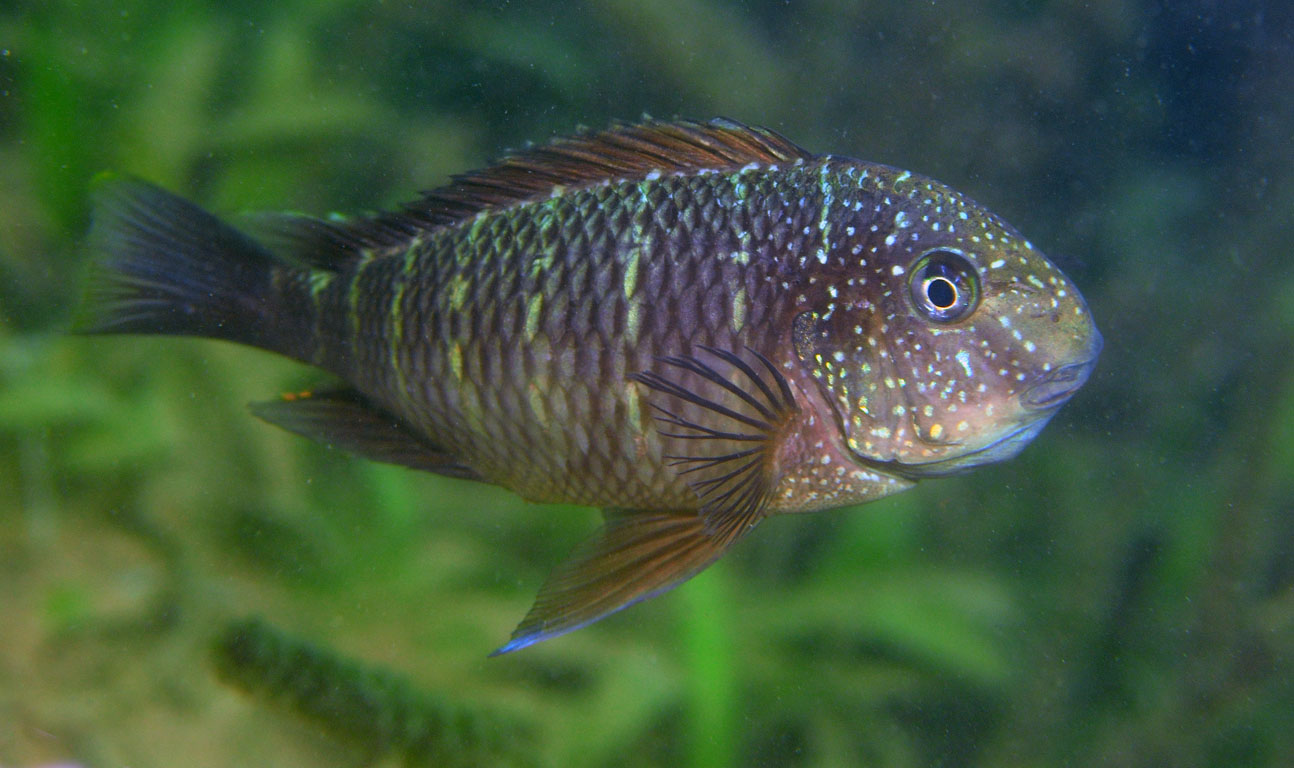 A mouthbrooding female of Tropheus moorii Murago Tanzania, photographed on Sep. 8th, 2021 at Wampembe
A mouthbrooding female of Tropheus moorii Murago Tanzania, photographed on Sep. 8th, 2021 at WampembeWhile we were at the lake last October we wanted to do a survey of the Ophthalmotilapia boops “Neon” at Nkondwe Island and the Murago Moorii at Wampembe. Very uncommon for the time of year there was a dense algae bloom at Kipili which extended all the way to the shores of the Mahale Mountains. This had us cut short our northern trip and hoped for clearer water south of Kipili. At Wampembe the water was reasonably clear and the three of us (Pam Chin, Enea Parimbelli, and I) tried to assess the density of the T. moorii “Tanzania Murago” which we all agreed was close to a “normal” density what could be expected of a T. moorii population. I swam about 75 meters till I had counted 50 adult Muragos. However, about a month later an official survey conducted by the governmental institutions NEMC (National Environment Management Council) and TAFIRI (Tanzanian Fisheries Research Institute) found that there were only 154 Tanzania Murago left in the entire population (about 700 meter shoreline). It is possible that a collector had made a large collection in the few weeks in between or we were diving in a spot where the population still seemed healthy. Also surprising was that they counted only 54 male O. boops around Nkondwe Island which should have been 10 times as many for a healthy population. We did dive there early October but the visibility was less than 50 cm because of the algae bloom.
Another species of concern is the so-called Firefry Tropheus, the deep-living T. brichardi that shares the rocky habitat with T. moorii at Mtosi. We did dive there last October and I found just a single adult and two juveniles. The survey of NEMC resulted in just 15 specimens in the entire Mtosi Bay!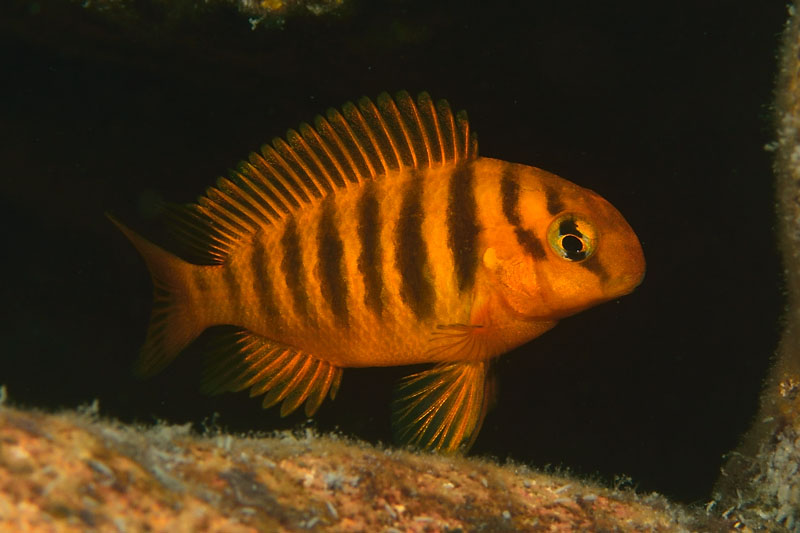 A juvenile of Tropheus brichardi Fire-Fry, photographed on Sep. 9th, 2021 at Mtosi
A juvenile of Tropheus brichardi Fire-Fry, photographed on Sep. 9th, 2021 at MtosiThe money to perform this survey was raised by the Horsfalls with a very important input from the German Zoological Society for the Conservation of Species and Populations (ZGAP —Zoologische Gesellschaft für Arten- und Populationsschutz).
The function of the Tanzanian NEMC (right-click and hit translate, unless you are fluent in Swahili) is to undertake environmental enforcement, compliance, review and monitor environmental impact statements, research and to raise awareness. After the teams left Lakeshore Lodge early December, Chris and Louise shared with me their conclusions and recommendations:
In their (NEMC) proposal they are going to recommend that the Government start to regulate the number of each species that is extracted as well as which sex. They are going to recommend that there is a quota system whereby the extractor companies as a whole are not able to take more than a sustainable number of the cichlids. They are also going to recommend that the local villagers become custodians of the cichlids in their area. That the individual villages oversee the extraction process, that the individual villages collect payments from the extractor boats so that they have a direct benefit and a reason to protect their cichlids. No further actions/recommendations have been reported so far.
Another encouraging development is the founding of the NGO SUSTAIN LAKE TANGANYIKA by Chris and Louise Horsfall. The NGO is committed to safeguarding the Lake Tanganyika ecosystem whilst improving the welfare of her local communities. They started already several different projects towards that goal.
1. Protecting the most important biodiversity hotspots of Lake Tanganyika—they start with making Nkondwe Island a no-fishing spot. Our Fund has recently sent $2000 in support of this project. An aerial view of Nkondwe Island. Photo by Shibumi Films.
An aerial view of Nkondwe Island. Photo by Shibumi Films.2. Breeding the most endangered cichlids to offer exporters an alternative to wild caught cichlids for sale to the aquarium trade. What they have been doing the last 4-5 years with three endangered species they want to expand to at least 10 species of concern.
3. Starting an aquahub growing Lake Tanganyika tilapia (Oreochromis tanganicae) with a hatchery, food processing machine, and training facility. Thus offering a more dependable and sustainable food source whilst providing fingerlings, fish food, and training to local entrepreneur fish farmers. See photos of their operation here.Lake Malawi
On July 21st the Lake Malawi National Park demarcated the 100 m protected no-fishing zone around the Nkhudzi Headland part of the park with red buoys. A few days later a similar demarcation was put in place on the other side of the Nankumba Peninsula, near Msaka and Otter Point. This is an important step in the right direction but the demarcation will only be effective if it coincides with proper instruction to local fishermen and most of all to the many illegal trawlers.
Now that the no-fishing zone is properly demarcated it is simple to tell whether they fish in the forbidden zone or not. Unfortunately, even after the publication of the corruption of village chiefs and fisheries officials (see article here) and their involvement with the illegal fish activities, they continue to happen on a daily basis. Now it appears that some of the vessels have obscured their names so that they cannot be identified. One of the many pair trawlers that devastate the lake's fish population on a daily basis.
One of the many pair trawlers that devastate the lake's fish population on a daily basis.
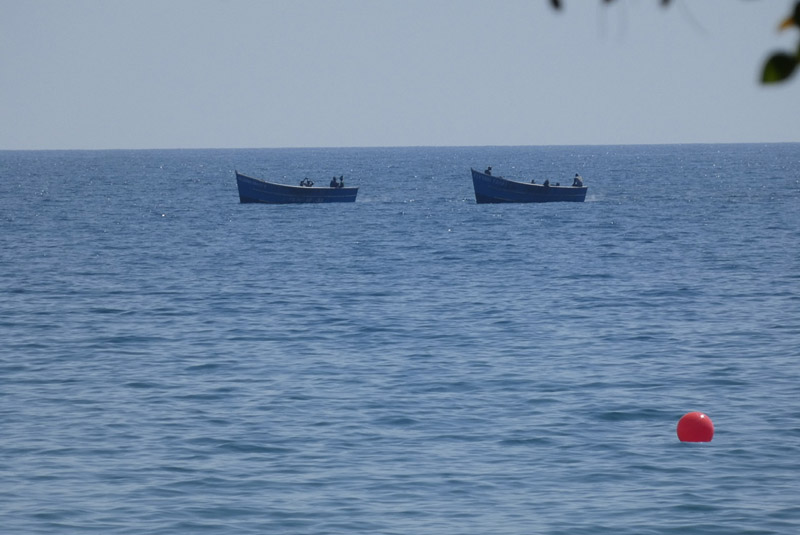 Another pair trawler with one of the demarcation buoys in the foreground.
Another pair trawler with one of the demarcation buoys in the foreground.
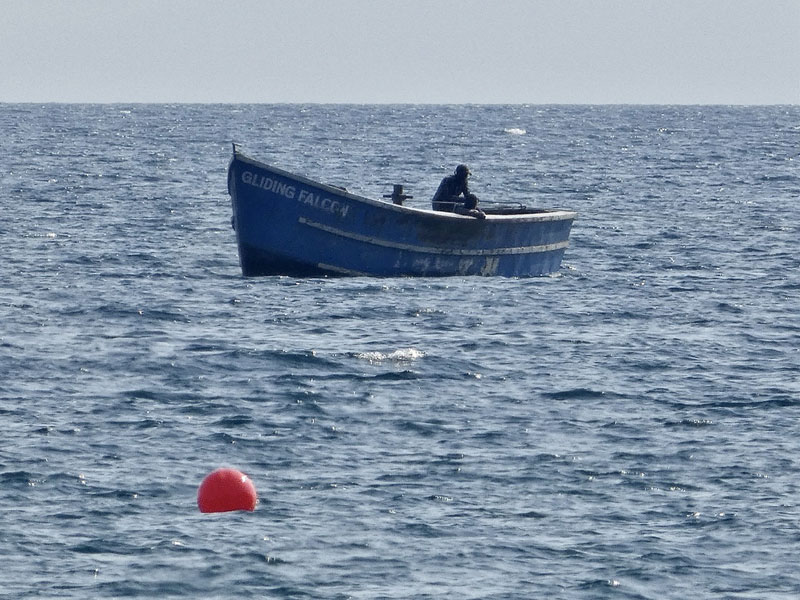 A trawler in shallow water within meters of the no-fishing zone.
A trawler in shallow water within meters of the no-fishing zone.
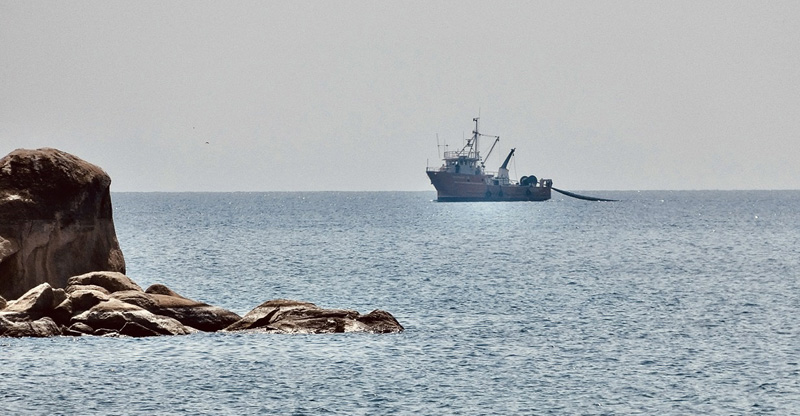 The huge R.V. Ndunduma, officially a research vessel of Fisheries, but trawling on an almost daily basis for the lucrative sale of fish. Although the vessel is based in Monkey Bay no fresh fish, apart from some Usipa, is available in the local markets there. Their catch is more valuable in the bigger cities like Lilongwe and Blantyre. Photos by George Mkondiwa.
The huge R.V. Ndunduma, officially a research vessel of Fisheries, but trawling on an almost daily basis for the lucrative sale of fish. Although the vessel is based in Monkey Bay no fresh fish, apart from some Usipa, is available in the local markets there. Their catch is more valuable in the bigger cities like Lilongwe and Blantyre. Photos by George Mkondiwa.It is really disheartening to hear about this situation, and I believe little can be done to this government-backed trawling activity. I thought I had seen the last pair trawlers (two larger boats in tandem with a huge trawl net in between them) in the late 1980s, early 1990s because they had wiped out most populations of sand-dwelling cichlids in the southeastern arm of the lake. With the population growth pressure and increasingly corrupt authorities, pair-trawling has again taken a devastating swipe at the fish of Lake Malawi. The nets now being used have a maze size of less than 1cm. Even so, most fish have already been extracted by these pair trawlers and instead of hauling in a net every hour they now need to let it drag the lake bottom for 4-5 hours.
Another piece of concern is the fact that Chinese “businessmen” continue to subcontract local fishermen not only for fish but also to sell them turtles and that this is not just happening all along the lake but going on in Monkey Bay and surroundings as well. They also reportedly buy anything else — snakes, lizards, crocodiles, crabs, mussels, birds, insects, and of course pangolin.
Geoff Furber of Ripple Africa had another victory in protecting Malawi cichlids (and safeguarding future fish for the communities living around the lake) with the signing of Fisheries Bylaws in Salima District on May 7 this year. See a pdf of the bylaws here. A few photos of the signing ceremony and the newspaper report follow below.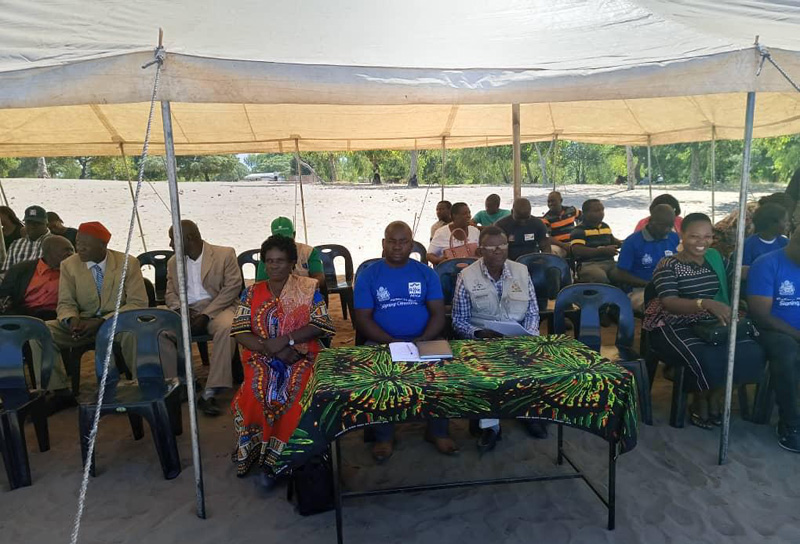 Dignitaries and community shareholders at the signing of the fisheries bylaws
Dignitaries and community shareholders at the signing of the fisheries bylaws
 Salima District dignitaries holding the signed fisheries bylaws.
Salima District dignitaries holding the signed fisheries bylaws.
 The Nation's report about illegal fishing gear entering Malawi and the signing of the Salima District bylaws
The Nation's report about illegal fishing gear entering Malawi and the signing of the Salima District bylawsRipple Africa has done so now in the Nkhata Bay District and in the Nkhotakota District. They bring together all stakeholders to agree to a plan for the district. New fishing bylaws are drawn up, volunteer Beach Village Committees are established and are empowered to manage the fishing in their area by making community members aware of the local bylaws, confiscating illegal nets and fining offenders.
Ripple Africa is fighting an uphill battle in the southern part of the lake in the last two districts, Dedza and Mangochi, as here they have to deal with the many illegal trawlers that greatly impact the local fisherman. I think that the situation for the local fishermen can only improve when these pair trawlers can be controlled or altogether stopped operating. Since these trawlers are fishing within a few meters of the park’s no-fishing zone demarcation there is no alternative for the local fishermen then to set their gill nets in park water as they are afraid to do anything against the trawlers with their corrupt governmental backers. Ripple Africa has been very successful in empowering the local fisherman in the northern part of the country. Their 10-year involvement resulted in more and bigger fish for the local communities as this man is happy to point out.
Ripple Africa has been very successful in empowering the local fisherman in the northern part of the country. Their 10-year involvement resulted in more and bigger fish for the local communities as this man is happy to point out.
Photo by Ripple Africa.Thank all of you who have contributed to the Fund to conserve the cichlids in lakes Malawi and Tanganyika. Thank you!
Ad Konings

 mvh
mvh
Mikael W
(NCS-medlem sedan 1981)Kommentar


Kommentar